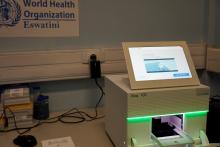Evidence-informed approach to improve DRTB treatment success in Eswatini
Eswatini is a high-burden country for both Tuberculosis (TB) and HIV. According to the 2022 Global Tuberculosis report, 4 200 new cases of TB (348 cases per 100 000 people) are reported each year in the country, of which 65 percent are co-infected with HIV. In addition, Drug Resistant TB (DR-TB) was identified in 44 percent of previously treated TB cases and in 5 percent of new TB cases. To improve the programmatic management of DR-TB the World Health Organization (WHO) provided technical assistance to Eswatini’s Ministry of Health (MoH) and convened a variety of stakeholders. This resulted in the revision of the DR-TB diagnostic algorithm, the introduction of targeted genome sequencing, the revision of treatment regimens, and the rapid adoption of all-oral, shorter regimens for DR-TB. These efforts shortened time to diagnosis, increased the detection of previously missed mutations, and improved patient acceptance of treatment, leading to a countrywide improvement in DRTB treatment success rates from 74 percent in 2018 to 81 percent in 2021.
How did Eswatini, with the support of the WHO Secretariat, achieve this?
The Eswatini MoH conducted a nationally representative Anti-TB Drug Resistance Survey (TBDRS) in 2017-2018, with the WHO providing technical support to develop a protocol, implement the survey, analyze the data, and interpret the findings. The survey revealed that approximately 60 percent of Mycobacterium tuberculosis complex (MTBC) strains in Eswatini contain a rifampicin resistance mutation called the rpoB Ile491Phe mutation [1]. This mutation is not detected by classic WHO-recommended diagnostic tests, resulting in cases of true rifampicin-resistant TB being incorrectly diagnosed as rifampicin-sensitive and patients being initiated on the wrong TB treatment regimen. The survey findings highlighted an urgent need to review the country’s diagnostic technologies in order to detect the mutation, as the current programme was missing MDR-TB cases resulting in poor treatment success rate.
“The Eswatini TB programme is open to explore new innovations and we are ready to implement and learn. As a programme, we have created a conducive environment that encourages partner support and fruitful collaborations” – Mr Themba Dlamini, National TB Program Manager, Eswatini
In 2019, a small team was formed by WHO during Eswatini’s TB programme review to evaluate diagnostic algorithms and treatment regimens, and to make recommendations to address the missed mutations. Guidelines were rapidly revised to enable the early identification and treatment of presumed MDR-TB cases, and WHO recommended that an oral shorter treatment regimen be used under operational research instead of an injectable regimen, in line with WHO’s global Drug Resistant TB guidelines. This oral short regimen pilot study was implemented in 7 out of 14 Multi-Drug Resistant TB (MDR-TB) facilities in two regions of the country (Lubombo and Shiselweni), with financial support from Médecins Sans Frontières (MSF). In June 2021, the Green Light Committee (GLC) of consultants from the WHO Regional Office performed an independent assessment of the MDR-TB programme and recommended that the all oral shorter treatment regimen be offered in all 14 DR-TB sites. The oral shorter treatment regimen was subsequently scaled up nationwide from September 2021.
In 2020, WHO provided technical expertise to modify the diagnostic algorithm for DR-TB to incorporate new molecular sequencing technology. In response, the Ministry of Health of Germany funded the implementation of a targeted sequencing project through the Global Health Protection Programme. To ensure a smooth transition from policy to practice two iSeq 100 illumina Next Generation Sequencing machines were procured, along with reagents and supplies, and laboratory personnel were trained to conduct operational research. Due to the COVID-19 pandemic, the implementation of the project was delayed as supplies were shipped late and laboratory trainers were unable to travel to Eswatini. Despite this, by end of 2021, the new molecular sequencing technology was fully operational at the National Reference Laboratory.
"I am immensely proud of the technical support that WHO Eswatini, Regional Office and headquarters have provided to the Government of Eswatini in the fight against drug-resistant tuberculosis. Through effective partnership and collaboration of stakeholders Eswatini was able to translate local evidence to policy and adopted technologies and treatment regimens that are necessary to improve the outcomes of those infected with multi drug resistant TB. This leap forward would not have been possible without the strong commitment of the Government of Eswatini, the ongoing dedication of WHO and other key partners including the German Government, Medecins Sans Frontieres, and the U.S President's Emergency plan for AIDS relief (PEPFAR)".
– Dr Geoffrey Bisoborwa, Acting WHO Representative, Eswatini.
In 2022, the MoH officially launched a targeted sequencing project, forming a Clinical Advisory Committee (CAC) to provide guidance on how sequencing data could be used for personalized treatment regimens for patients. The CAC is a multidisciplinary team, comprised of clinical, laboratory, pharmaceutical and public health experts, all coordinated by the Programmatic Management of Drug Resistant Tuberculosis (PMDT) Technical advisor at the National TB Programme. With the support of WHO and the CAC, the MoH is hoping to be able to develop standardized treatments and train clinicians in the near future, based on the comprehensive analysis of a large pool of sequencing data. Further investments in capacity building for data analysis is however essential to make this a reality.
Patients and clinicians have reported increased satisfaction in the diagnosis and treatment of DRTB, thanks to an evidence-informed approach and multi-stakeholder collaboration. An evidence-based approach was used to identify the problem, while the collaboration of various stakeholders was essential to formulate national guidelines, mobilize resources, and put in place the necessary changes to solve it. In Eswatini, case finding for both TB and DRTB remains a critical issue, with only 49 percent and 31 percent of cases, respectively, being detected. Addressing this gap requires the allocation of resources to investigate the problem and devise effective solutions.





